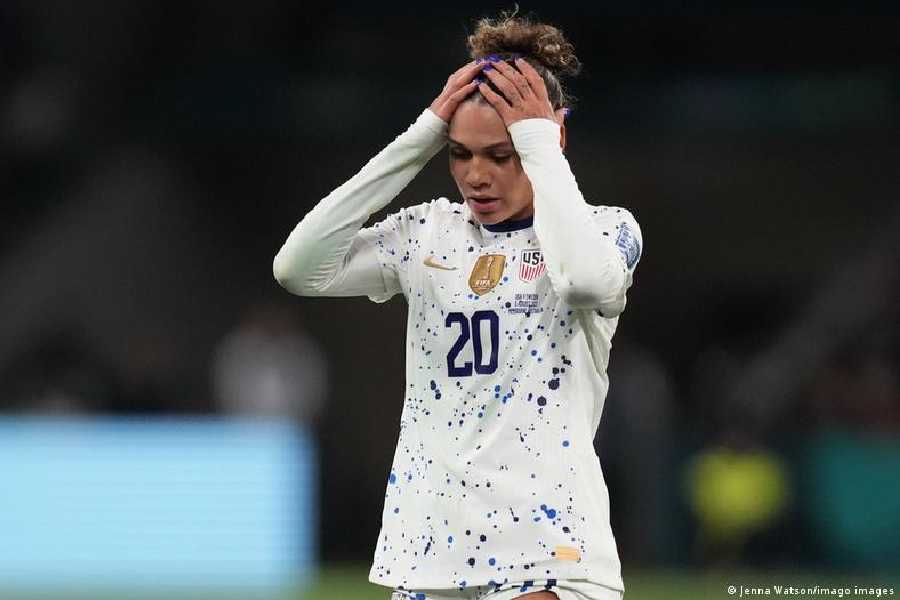Ignorance to women's health and its potential to dramatically enhance sporting performance is holding back women's sport, according to a leading sports scientist.
Dr. Emma Ross, who helped devise health and fitness plans for the British Team in the 2016 and 2020 Olympics, told DW that health inequalities are even more acute in sports than in society.
"Sport is this perfect storm, because you've got women who don't understand their bodies and are normalizing a lot of things that aren't normal; you've got a lot of men who don't even have the experience and perspective, however well-intentioned they are; and then you've got a system, which is pushing people's bodies to the limit.
"It's very competitive and high pressure, and you absolutely don't want to appear fragile. But there are stigmas attached to some of these issues and sport compounds all of those things. That's why we're having to work quite hard to change the system to be able to acknowledge and support women's health."
Ross identifies menstruation and reproduction, breast support, appropriate kit and nutrition as areas where most female athletes need to be provided with much better education and understanding.
The explosive growth of women's football in England since the Euros in 2022 has seen a little more light cast on some of these issues.
Chelsea and soon to be USA manager Emma Hayes has discussed menstrual cycles at press conferences, more players have returned to the top level after giving birth and a glut of anterior cruciate ligament injuries to high profile players has led to discussions about footwear, playing on poor pitches and the overloading of the women's football calendar.
That systemic inequality is not just within sports.
"Women and girls often face greater barriers than men and boys to accessing health information and services," reported the World Health Organization in 2021.
"These barriers include restrictions on mobility; lack of access to decision-making power; lower literacy rates; discriminatory attitudes of communities and healthcare providers; and lack of training and awareness amongst healthcare providers and health systems of the specific health needs and challenges of women and girls."
It is those needs and challenges that Ross is trying to address through a newly-expanded partnership between the English football assocation (FA) and health business The Well HQ, of which she is a founder.
While some obstacles and attitudes may take years to overcome, others should be easier to address, Ross said, pointing to breast support as an underreported issue which makes a big difference. Studies show that women with larger breasts do 37% less exercise and, at the top level, not accounting for that with the right sports bra can make an enormous difference.
"It's significant physiologically. You increase the energy cost of an exercise. If your breasts are moving, you increase perception of effort – if you're running at exactly the same speed, if you haven't got good breast support, it feels harder. You also might have more pain, which then has a knock on effect to performance, your stride length changes if you haven't got good enough breast movements, so it shortens and you cover less ground with every stride.
"When we did a big sports bra project ahead of the Tokyo Games (held in 2021) in my previous role, 50% of the athletes weren't in the right style of bra to support them optimally. So we normalize it. I think everyone thinks if you're born in a female body, you know how it works and how to get the best out of it. And unfortunately, that's just not the case."
Another issue that concerns Ross is nutrition. Her experience has been that societal attitudes to body shapes often means women eat much less than men, particularly where carbohydrates are concerned. Given the amount of energy that athletes expend, this often leads to their reproductive cycle stopping, something Ross said is seen as "normal" but which can affect bone, muscle and brain health, as well as immune function.
"What we see in girls who under-fuel is that if you fast forward three, four or five years, they start to develop osteoporosis because they haven't got the hormones to help them build bone strength. So lots of girls will present with a bone stress injury, like a stress fracture. And that's the first time the underfueling will get picked up because your bones are now not growing strong."
Ross adds that there is also a mental health risk that accompanies underfueling, which impacts performance and career longevity.
"We need to do much better with that, because the burden of that on sport at the moment, I think, is much more than we know, in terms of how many females don't achieve their potential because they didn't get that bit right."
That lost potential also applies to girls who don't pursue sport even at grassroots level because their periods are too heavy, their breasts are not adequately supported or their pain levels are too high.
The understanding and study of women's health has a long way to go in broader society, but sport may have a pioneering role to play, even if that means framing progress as vital to performance, rather than improved wellbeing.











